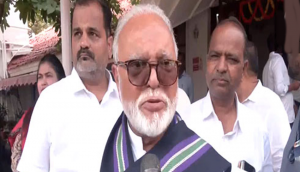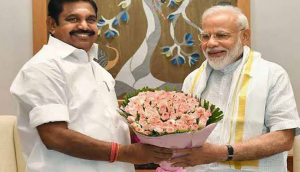Catch 2017: Modi-Shah ruled the roost but Gujarat polls were a wake-up call for BJP

Despite a faltering economy, reeling under the double whammy of demonetisation and a faulty GST rollout, 2017 saw the Narendra Modi-Amit Shah led Bharatiya Janata Party continuing its electoral dominance with 19 states now under its kitty.
Ever since Modi’s emphatic victory in 2014 the country has witnessed a saffron surge and 2017 was no different. The BJP formed governments in six of the seven states that went to the polls this year. The icing on the cake for the BJP was the election of Ram Nath Kovind as the President of India, the first BJP leader to occupy the post.
BJP’s victory cavalcade did roll on to its citadel of Gujarat but the win was far from convincing and indicates the party is no longer invincible in the state where it has been ruling for more than two decades.
Assembly elections in five states
The Assembly elections in the five states of Uttar Pradesh, Uttarakhand, Punjab, Goa and Manipur were perceived to be litmus test for the BJP following Modi’s highly ambitious and shocking demonetisation move.
Notwithstanding the endless miseries caused by demonetisation and the Opposition making it a major poll issue, the BJP scripted a mammoth victory.
Riding on communal rhetoric led by Modi and Shah, the BJP in Uttar Pradesh decimated the ruling Samajwadi Party which had stitched and alliance with the Congress. The party bagged 324 of the 404 seats in the country’s largest state.
The surprise move to appoint Hindutva poster boy Adityanath as the Chief Minister also created ripples in political circles. Known for his inflammatory speeches, the controversial hardliner faces a number of criminal cases including that of attempt to murder and rioting.
Besides wresting power in Uttarakhand from the Congress, the BJP managed to form government both in Manipur and Goa despite the Congress emerging as the single largest party in both the states.
The BJP managed to get backing of independent MLAs and defectors to form the government in the two states prompting the Congress to accuse it of using money power.
The only saving grace for the Congress was Punjab where the grand old party unseated the BJP which was in power in alliance with the Shiromani Akali Dal (SAD) for the past 10 years.
The BJP-SAD alliance managed to win only 18 seats. Captain Amarinder Singh of the Congress was sworn in as the chief minister.
President and Vice President elections
Amid rising backlash over nationwide incidents of lynching and violence against Muslims and Dalits, the BJP sprung a surprise nominating former Bihar Governor Kovind, a Dalit, as the NDA presidential nominee.
The Congress made it a Dalit vs Dalit contest by fielding former Lok Sabha Speaker Meira Kumar as the Opposition nominee but Kovind won becoming the second Dalit Presidet of India after KR Narayanan.
Subsequently, NDA candidate and former Union minister Venkaiah Naidu was elected the 13th Vice President. Naidu defeated Gopal Krishna Gandhi, grandson of Mahatma Gandhi.
Nitish Kumar's gharvapsi
The year also witnessed friend-turned-foe Bihar Chief Minister Nitish Kumar turning a friend again when he walked back to the NDA ditching the much talked about grand alliance with Lalu Prasad Yadav's Rashtriya Janata Dal (RJD) and Congress.
Known for his clean image Nitish Kumar was touted as the potential face for a united Opposition against the BJP. But with Lalu Prasad and his family grappling with corruption charges, Kumar rejoined the NDA, giving a body blow to the Opposition unity bandwagon.
Gujarat RS polls
Though elections in India are usually full of drama, the Rajya Sabha poll in Gujarat in August was nothing short of a potboiler. Congress leader Ahmed Patel managed to retain his seat for a fifth term, in a battle of prestige between the Congress and the BJP.
Battling defection, horse trading and revolt within the party, Patel, political secretary to erstwhile Congress president Sonia Gandhi, managed to scrape through courtesy the Election Commission’s move to invalidate votes of two Congress legislators for showing their ballot papers to the BJP's election agent.
With several of its legislators quitting the party and joining BJP, the Congress shipped all its Gujarat MLAs to Karnataka to prevent them from getting poached.
Assembly elections in Gujarat and Himachal Pradesh
While the Himachal polls went on the predicted lines with BJP scripting a comfortable victory, the real battle was in Modi-Shah’s home state of Gujarat where besides the Congress, it was up against the troika of Patidar leader Hardik Patel, youth Dalit leader Jignesh Mevani and OBC leader Alpesh Thakor.
Led by Rahul Gandhi, Congress intensely campaigned against Modi’s economic policies particularly GST that had hit the business in the state.
With the state plagued by farm crisis and reeling under demonetisation and GST, the BJP yet again had to rely on Modi’s charisma. The Prime Minister preferred to postpone the Winter Session of Parliament and carpet-bombed the state with a series of rallies to turn the tide.
Refraining from bragging about the much-hyped Gujarat Model, the BJP campaign harped mostly on Congress bashing and it’s tried and tested formula of communal polarisation.
Far from Amit Shah’s assertions of 150+ seats, the BJP managed to win just 99, mostly in urban areas of Ahmedabad, Surat, Vadodara and Rajkot.
While the BJP may celebrate being in government in 19 states, the Gujarat polls have set alarm bells ringing.
Gearing up for the 2019 Lok Sabha polls, the party has to address a lot of key issues particularly on the economic front.
First published: 30 December 2017, 18:59 IST





![BJP's Kapil Mishra recreates Shankar Mahadevan’s ‘Breathless’ song to highlight Delhi pollution [WATCH] BJP's Kapil Mishra recreates Shankar Mahadevan’s ‘Breathless’ song to highlight Delhi pollution [WATCH]](https://images.catchnews.com/upload/2022/11/03/kapil-mishra_240884_300x172.png)

![Anupam Kher shares pictures of his toned body on 67th birthday [MUST SEE] Anupam Kher shares pictures of his toned body on 67th birthday [MUST SEE]](https://images.catchnews.com/upload/2022/03/07/Anupam_kher_231145_300x172.jpg)






